#gnostic influences
Explore tagged Tumblr posts
Text
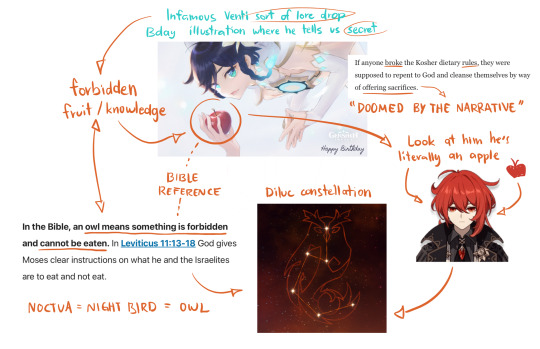
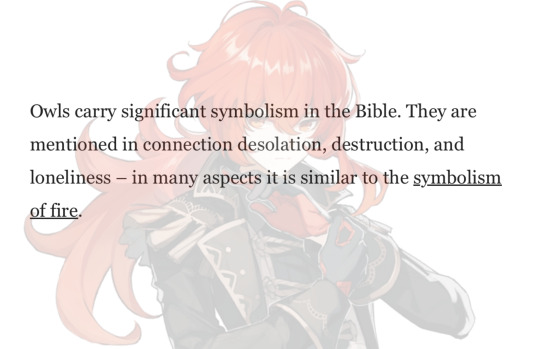
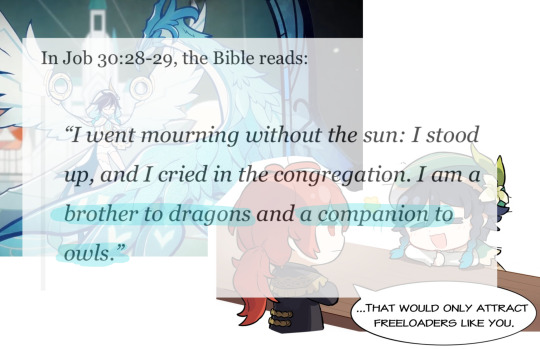
New diluven conspiracy board dropped.
#diluven#venluc#diluc ragnvindr#genshin venti#venti the bard#genshin impact#thank god genshin is heavily influenced by gnosticism and i can use my brain knowledge as a church kid to make stuff like this#😭😭😭
445 notes
·
View notes
Text
I love video essays made by trans women rn I’m listening to one abt utena. I need one abt Morrowind pls pls pls
#not just ‘here’s what happened. the gang is good for these reasons’#I want themes I want analysis I want cultural explorations#I want someone to talk abt kirkbride’s inspiration from Crowley#I want how his Gnosticism influenced it#…. please don’t make me do it#I can’t write a coherent video essay. let alone edit one
10 notes
·
View notes
Text

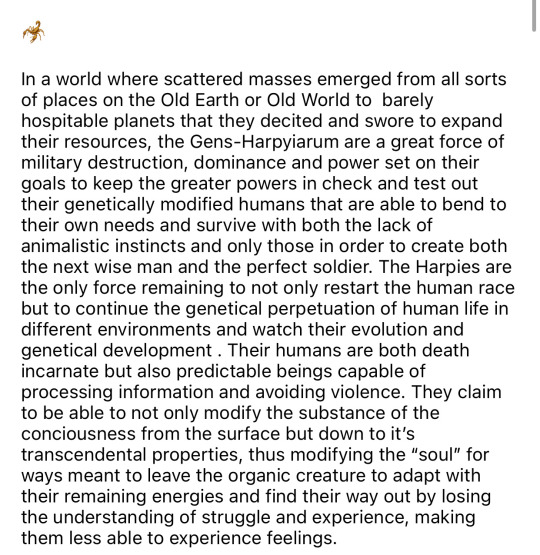
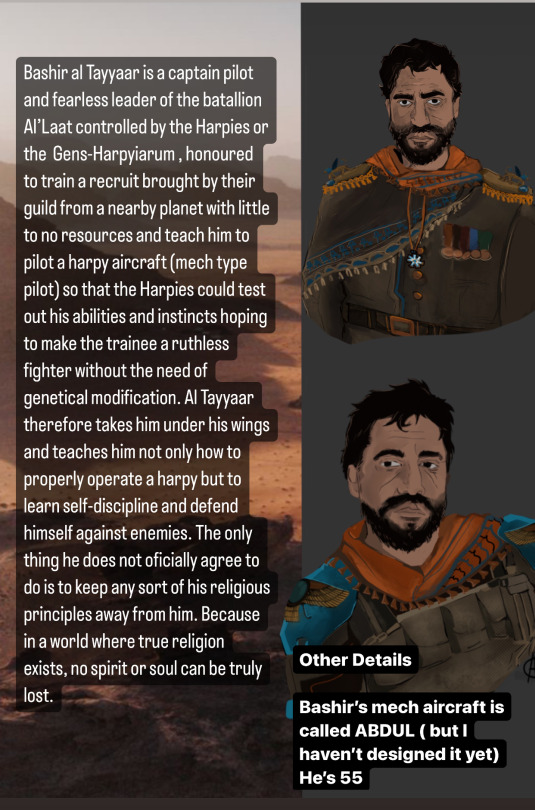
New plot ideas that are barely settled and designs for The Overseer (haven’t decited on the name for this project yet. ) sure, yes. I have a few.
(First concept draft written on my phone please give me ideas for this WRITING SCI FI AS SOMEONE WHO NEVER WROTE SCI FI BEFORE IS HELL I NEED HELP!!)
#art#digital art#my art#digital illustration#artwork#ocs#oc#mythology#inspired by dune#inspired by titanfall#mech pilot#mech pilot oc#islam influences#arabic#inspired by babylonian mythology#gnostic
5 notes
·
View notes
Text
TIL that in the end of the Bible the 144000 people who dont get burned in the lake of fire end up going to a cube in the sky and this is what heaven is. yall have been scammed. so hard. I cant believe ANYONE is still a christian in the year 2023.
#theres ppl whove read the bible who think its all bs#christianity is a plant from the global saturnian cult#to trick yall into worshipping saturn the black cube#and giving the parasitic matrix the fear / worship energy it desires#ask anyone whos actually read the bible with a clear unbiased head#watch dan from theoverwatchleague#seriously they program you from birth to apologize for the bible and read it thru a very specific lens#they program you to do INSANE mental gymnastics to rationalize how the Christian god is good and the truth and peaceful no matter what#Christian theology is an entire field that exists to rationalize ppls childhood Christian programming that theyre too stupid to let go of#when you read the bible like someone who's hearing of it for the first time#not like some biased programmed shmuck#the truth is as clear as day#they also in <700 AD killed the gnostics and erased reincarnation from christian doctrine thru killing the pope that believed in it#the christianity that you think is authentic truth of Jesus Christ is extremely filtered and controlled by the matrix#the matrix has leveraged Jesus' influence to create a Saturnian cult and yall fall for it still#christianity#bible#bible thumpers#brain damage
4 notes
·
View notes
Text
youtube
#spiritual enlightenment#lost gospel of thomas#gnostic teachings#jesus teachings#hidden teachings of jesus#spriritual seeking and authority#supreme realization#spiritual enlightenment and transformation#spiritual transformation with jesus#seeking supreme realization#exploring jesus#teachings of jesus#meditation for beginners#self realization#testimony influenced#holy spirit to reveal to you gods will#spiritual transformation by supreme realization#Youtube
0 notes
Text
To be clear, gnostics believed that the Demiurge did create the world- they're real and a God by that metric. There's just also a more "true" God who created heaven and souls that the Demiurge was imitating in creating the physical world. The physical world is full of suffering and pain because the Demiurge is either malicious or incompetent.
The evil God being "false" (which just means they're not the truly most powerful being or highest authority) is because it's ultimately a strange sect of Christianity, and the Bible consistently holds that God is loving and kind to humans on an individual level, which is the source of the initial "if God is all knowing, all powerful, and all loving, why does suffering exist" problem. So the God that is evil/incompetent must be false to square with that.
Plus, "all suffering comes from the one true God, who hates you, and all joy and hope comes from a false God" is a bummer to most people, especially ones who believe in hierarchy the way people living under feudalism did, and religions that are bummers don't tend to last super well or catch on.


This story's conception of God is so interesting. An actively hostile force that enjoys toying with people's lives. A spiteful, malevolent presence. An obstacle to hate, to feel spite towards and overcome. For most of the cast, killing God is the ultimate goal. It's... relatable.
#take my gnosticism explanation with a grain of salt most of what i know about it i learned from trying to figure out homestuck#also and I'm gonna gesture vaguely at endgame spoilers next demily so dont read#theres stuff mentioned in the climax that implies the demiurge comparison isn't as off base as you'd think#like definitely not an influence but the comparison holds some water
269 notes
·
View notes
Text
Splashtail and Atheism
Hello. I am an Atheist and I call Splashstar an Atheist because he is based on widespread bigoted depictions of godless people like myself. There have now been several posts about this written as if they're trying to "correct a misconception," and I am tired of vagueposts completely missing the point of the criticism to get caught up on arguing semantics.
The misanthropic, god-hating "Atheist" character in Christian propaganda, which I feel Splashstar has some alarming similarities with, does not come from the writer's correctable "misconception" of irreligious labels. It is born from a hatred of nonbelievers.
Specifically, my point that Splashtail is a mashup of two popular anti-secular tropes common in religious media;
The assertion that there's no such thing as a "real" nonbeliever, and that Atheists are just "rebelling" against God because we're mad at him, want to do bad things without guilt, or have "lost our way."
The belief that morality itself stems from faith in a higher moral being, asserting that the irreligious are "evil" in contrast to the faithful.
Even passing familiarity with the arguments of Christian apologia seen in Chick Tracts, Pureflix films, PragerU videos, and so on, will have put these tropes in front of you. They are false and harmful, and they target Atheists.
For more on this, TVTropes has an entire article dedicated to the Hollywood Atheist and its sub-tropes. Note how many of these Curlfeather and Splashtail fall into, regardless of if you're arguing that they are "real atheists" or not.
Those that hate us do not care about semantic labels. To them, we are without God, A-Theistic, and they do not actually care what is at the core of your beliefs if it contradicts their narrative.
But, even worse, the "Splashtail Can't Be An Atheist" crowd isn't even totally correct on the semantics they're trying to have a pedant battle about.
Most atheistic organizations and online atheists define Atheism as "one who does not believe in God" and attempt to push a sliding scale of "agnosticism" on how hard of a "maybe" you're feeling about your lack of faith. In the sliding agnostic scale, Agnostic Atheists are a "probably no god" and Gnostic Atheists are a "definitely no god." Others describe that scale as "hard" and "soft" Atheism-- but there is NOT universal agreement on that definition.
There other definitions of an "Atheist," and even those who reject the "agnostic scale" completely (I am one of them). "Atheism" was historically the catch-all term for what we might now call "Irreligious," and more.
The Encyclopedia of Philosophy explores its many meanings, and proposes that what defines an Atheist is an active choice to distance oneself from faith; "Someone who rejects the premise of gods either based on lack of belief, or meaninglessness of the question." Matt Dillahunty, a prominent educator and activist, intentionally refers to himself as an Atheist when others (including religious people!) have tried to pressure him into using the label Agnostic, for reasons he covers in great depth. Historically, "atheist" simply meant anyone who denied the gods or acted impiously, evolving into use as a broad label for irreligious practices around the 1500s, until attempts to narrow it to "nonbelievers in deities" in the 1800s.
By EoP's expanded definition alone, Splashstar qualifies as an Atheist. The rejection does not have to come from a belief that Theism is false, but that the question is meaningless. He doesn't have to "believe" in StarClan any more than you have to "believe" in a total stranger. He rejects faith in it and lives without their influence.
But even more than that, "atheist" is a broad, stigmatized term with a history you can't erase. Hundreds of combinations of philosophies, spiritual beliefs, and logical positions have been called "Atheism."
"Atheist" can refer to Agnostics (those who aren't sure if there is a god or not), Antitheists (opposition to the belief in and/or worship of gods), Igtheists (those that feel that "god" is such a nebulous term that the question of belief is meaningless), Apatheists (people who just don't care), practitioners of Non-Deistic religions (such as Humanistic Judaism and some sects of Buddhism), and even heretics who spoke against religion like Diagoras of Melos (gay guy who chopped up a statue of hercules and used it to bake beans. king.)
In a fantasy universe where gods are provably, visibly real, the term "Atheist" is going to look a lot more like those historic and expansive uses.
Unless you want to argue that "atheism" by the narrow, popular definition of "believing in deities" can't exist in such a setting. So, arguing that Cloudtail stopped being an Atheist when he saw demons in OotS, in spite of this not affecting his spiritual practices. Or, dancing around using one uniting term, you could specifically say Curlfeather is a Misotheist, Splashstar is an Antitheist or Agnostic, Mothwing is Deist, etc.
You could have a discussion about how applicable these words even are in the setting. Or make up terms that satisfy yourself. You could do this forever. But I choose not to.
I think it's counterproductive to push people to learn a bunch of terms for hyperspecific branches of irreligious philosophy just to discuss clear anti-secular sentiment within the text of a book, actually. Or push people to abandon a useful word because fantasy isn't exactly the same as real life. Functionally, imo, all of those aforementioned cats are Atheists within this setting, living "without god" by rejecting belief-- and many of them invoke real world bigotry, with tropes much older than WC itself.
So the simple fact is; Calling Splashtail an "Evil Atheist" immediately communicates the narrative tropes I am criticizing.
Either by authorial accident or on purpose, Splashstar's lack of morality being tied to his rejection of StarClan invokes the demonized atheist trope, very much like the ones seen in PureFlix's God's Not Dead or Jack Chick's The Last Generation.
All the arbitrary wishing that the terms were more narrow and exclusive will not change the reality that those characters are intended by bigots as atheists. The terms of the discussion reflect that. Trying to tut-tut the fandom for calling a spade a spade is a smug way to phrase you completely missed the damn point.
#I have seen several of these posts and I finally snapped#Hollywood Atheist is a trope that has been discussed for DECADES of media analysis#If you're gonna try to say that the Strawman Atheist in God's Not Dead is Um Ackshually not even a real atheist 🤓 youre going in the locker#actually wait ur going in the Matilda Chokey because maybe there you will find the point#on a personal level i also find the whole implication that there wouldnt be atheists in a fantasy setting with gods to be disturbing#Nothing about my personal beliefs would change if tomorrow it was revealed that there's a god somewhere#ergo you wouldn't need to change the label that describes me either.#I would still be a ''without gods'' atheist until proven to me that there's anything good that would come from belief in that deity#I guess it's weird to me that others imply that something WOULD change about them.#Splashtail#Splashstar#Atheism#Anyway now I have a sign to tap when this rolls around my dash
255 notes
·
View notes
Text
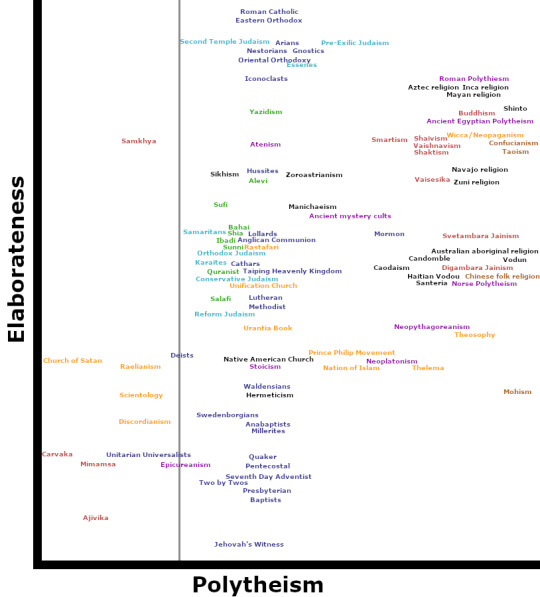
Revised version of "polytheism vs elaborateness" religion chart. I started with a list of around 150 religions, sects, denominations, philosophies, and spiritual tendencies, whittled down to 100 based on what I could find information on and what meaningful differences would actually show up in a chart like this. Dark blue is Christianity and Christian-derived tendencies; light blue is Judaism and Jewish-derived tendencies; green is Islam and Islam-influenced tendencies; purple is ancient Mediterranean polytheism and related schools of thought; red is Dharmic/Hindu-influenced schools of thought; tan is Chinese religion and philosophy; orange is new religious movements; black is other, unaffiliated religions and movements.
Obviously, "what is a religion" is a complicated topic. Some of the things on this chart might strike you more as philosophical schools (Carvaka, Stoicism), epistemological approaches (Unitarian Universalism), or different ways of slicing the same tradition. The scholarly definition of "religion" is sort of fundamentally circular, and that's not something I'm interested in trying to untangle for this entirely non-scientific exercise.
Religions etc. are scored on two axis: polytheism vs elaborateness of practice. Polytheism is a rank from zero to 11, thus:
0. Strict atheist and materialist, denying the possibility of both gods and the supernatural, e.g., Carvaka.
1. Atheist. Denies the existence of significant supernatural agents worthy of worship, but may not deny all supernatural (or psychic, paranormal, etc.) beings and phenomena (e.g., Mimamsa).
2. Agnostic. This religion makes no dogmatic claims about the existence of supernatural beings worthy of worship, and it may not matter for this religion if such beings exist (e.g., Unitarian Universalists). It does not preclude--and may actually incorporate--other supernatural, psychic, or paranormal phenomena (e.g., Scientology).
3. Deist. This religion acknowledges at least one god or Supreme Being, but rejects this being's active intervention in the world after its creation (e.g., Christian Deism). Deism is marked with a gray line on the chart, in case you want to distinguish religions that specifically care about all this God business from ones that don't.
4. Tawhid monotheist. This religion acknowledges only a single transcendent god above all other natural or supernatural beings, who is usually the creator of the universe and the ground of being, and is without parts, division, or internal distinction (e.g., Islam).
5. Formal monotheism. This religion acknowledges a single god, usually transcendent above all other natural or supernatural beings, but who may have aspects, hypostases, or distinct parts (e.g., Trinitarian Christianity). Pantheism may be considered a special case of formal monotheism that identifies the universe and its many discrete phenomena with a single god or divine force.
6. Dualism. This religion acknowledges a single god worthy of worship, alongside a second inferior, often malevolent being that nevertheless wields great power in or over the world (e.g., Zoroastrianism or Gnosticism).
7. Monolatrist. This religion or practice acknowledges the existence of many gods or divine beings worthy of worship, but focuses on, or happens to be devoted to only one of them (e.g., ancient mystery cults; pre-exilic Judaism).
8. Oligotheist. This religion worships a small group of divine beings, who may function for devotional or rhetorical purposes as a single entity (e.g., Mormonism, Smartism).
9. Monogenic polytheism/Henotheism. This religion worships many gods, which it sees as proceeding from or owing their existence to, a single underlying or overarching force or supreme god (e.g., many forms of Hinduism).
10. Heterogenic polytheism. This religion worships many gods, who have diverse origins and/or natures. Though the number of gods is in practical terms probably unlimited, gods are discrete entities or personalities, i.e., they are "countably infinite" (e.g., many polytheistic traditions).
11. Animism. This religion worships many gods which may or may not be discrete entities, and which may or may not be innumerable even in principle, i.e., they are "uncountably infinite" (e.g., many animist traditions).
What counts as a god is naturally a bit of a judgement call, as is exactly where a religion falls on this scale.
Elaborateness of practice is based on assigning one point per feature from the following list of features:
Uses vs forbids accompanied music in worship
Saints or intermediary beings accept prayers/devotion
Liturgical calendar with specific rituals or festivals
Practices monasticism
Venerates relics or holy objects
Clerics have special, elaborate clothing
Clerics have special qualificiations, e.g., must be celibate or must go through elaborate initiation/training
Elaborate sacred art or architecture used in places of worship
Sites of pilgrimage, or other form of cult centralization
Sophisticated religious hierarchy beyond the congregational level
Mandatory periods of fasting and/or complex dietary rules
Specific clothing requirements for laypeople
Specific body modifications either required or forbidden for laypeople
Liturgical language
Complex ritual purity rules
Performs sacrifice
Performs human sacrifice (or cannibalism)
Uses entheogens
Uses meditation or engages in mystical practice
Additionally, a point is taken away for austerity for each of the following features:
Forbids secular music outside worship
Claims sola scriptura tradition
Practices pacifism or ahimsa
Requires vegetarianism of all adherents
These scores are probably pretty inexact, since I am not a scholar of world religion.
This chart is not scientific, it's just a goof based on that @apricops post.
Other fun dimensions along which to chart religions might be:
Orthodoxy vs orthopraxy
Authoritarianism/control of members. This would add some much needed distinctions to Christian sects in particular, and to the new religious movements.
Elaborateness of cosmological claims. Some religions (looking at you, Buddhism) really go hog-wild here.
Social egalitarianism. Even within the same framework/tradition/philosophy, some practices differ radically on how egalitarian they are.
1K notes
·
View notes
Text


I made these charts to provide an easy reference guide for comparing the four Gospels! Feel free to share around wherever.
I think tumblr's crunching up these images so visit here for crisper versions (plus they're table format instead of png format).
Alt text version is under the readmore, necessarily formatted slightly differently but with all the same info.
TEXT ONLY / NON CHART VERSION:
Images show two charts, each credited to Avery Arden with a note that the material largely derives from the abridged version of Raymond E. Brown's An Introduction to the New Testament.
Chart 1: Comparing the Gospels, Part 1 – historical context
Mark
When:
Late 60s/early 70s
Who:
Jewish
Multi-lingual — peppers Aramaic into the Greek
Where:
Rome or Syria (clearly unfamiliar with Palestinian geography)
To whom:
Mainly to Gentiles new to Christianity who were experiencing persecution
Priorities:
Encourage audience and show them how their suffering fit into Jesus’ vision of the Kingdom of God
Matthew:
When:
Late 70s/80s
Who:
Jewish
Also multi-lingual, with Aramaic phrases;
Greek more polished than Mark’s
Where:
Probably in or near Antioch (in Syria); possibly Galilee
To Whom:
Mainly to well-educated Jews who were debating internally about how Jewish tradition fit into following Jesus
Priorities:
Promote Messiah Jesus who fulfills audience’s Jewish scriptures
inform church life and structure
Luke
When:
mid-to-late-80s
Who:
Gentile (possibly Jewish convert)
Educated Greek “historian” familiar with Septuagint; no use of Aramaic; expert use of Greek
Where:
Probably Greece; possibly Syria; also unfamiliar with Palestine
To whom:
Mainly to wealthy Gentiles influenced by Paul’s mission; living in an urban setting
Priorities:
Promote Isaiah-like Jesus; challenge audience to live out faith more actively (e.g., by redistributing wealth)
John
When:
90s / as late as 110
Who:
Jewish
Student(s) of “the Beloved Disciple” (the “Johannine school”)
Where:
Traditionally Ephesus; possibly Syria
To whom:
To a mixed crowd of Jews & Gentiles, at a time when tensions between Jews who did & didn’t follow Jesus had reached an all-time high
Priorities:
Promote Jesus’s divinity; strengthen unity in a group increasingly defining itself as separate from Jewish ones
Chart 2: Comparing the Gospels, Part 2 — Thematic Content
Mark
Emphasizes Jesus as:
Jesus as miracle-worker / healer; human being
Unafraid to depict human limitations & emotions in Jesus
Other defining attributes / content:
Focuses on Jesus’s actions, e.g., his miracles; as well as on his suffering and death
Originally ended with the empty tomb & fear; no resurrection relief
The disciples often fail to understand Jesus; Jesus is frequently secretive about his identity
Matthew
Emphasizes Jesus as:
A Moses figure, Messiah, Son of God; teacher
Removes descriptions that make Jesus seem limited, naïve
Other defining attributes / content:
Beatitudes (ch. 5); judgment of the “sheep and goats” (ch. 25);
Instructions for intracommunal relationships; forgiveness; “Great Commission” (ch. 28)
Polishes Mark’s depiction of the disciples to present them more favorably (esp. Peter as the “rock” of the church)
Luke
Emphasizes Jesus as:
Self-aware Son of God; prophet of the poor
Removes descriptions that make Jesus seem emotional, harsh, or weak
Other defining attributes / content:
Beatitudes (ch. 6) — with added “woes”; frequent warnings about risks of wealth
Also depicts disciples more favorably
Favorable depictions of tax collectors as sinners on the way to redemption;
negative views of Pharisees as rejectors of Jesus, juxtaposed with stories of Gentiles who express faith
John
Emphasizes Jesus as:
Divine, the Word / “I Am” made flesh; lamb of God
Often misunderstood by disciples & crowds due to his use of figurative language
Other defining attributes / content:
Poetic format, full of symbolism; similarities to Gnostic texts that arose in the same era
Lots of “testimony” and “signs”
Despite Jesus & his disciples being Jewish, John depicts “the Jews” as being against Jesus; his Jesus says things like “It is written in your law…”
248 notes
·
View notes
Note
Okay I'm the anon who sent that ask and thank you so much for answering but I'm also coincidentally fucking insane about gnosticism (side note: if you want to be insane about gnosticism with us be very careful, the esoteric antisemitism conspiracy community really love it and their videos will most likely suck you into the alt-right pipeline) and I agree with everything you said about Yaldabaoth but I raise you the most mind-boggling god that is Abraxas, Jake's denizen
He appears in actual gnostic texts from Nag-Hammadi library in passing, but his most haunting description comes from Jung (again, I want to be really clear, I'm just interested in philosophy of all this, Jung was an actual believer and kinda lost a grip on reality along the way)
In Seven Sermons Abraxas is an active god, who represents power, endurance and change. He exists above the god (who Jung calls Helios, the sun) and the devil, he's undefinable and all-powerful and his descriptions fucking SLAP
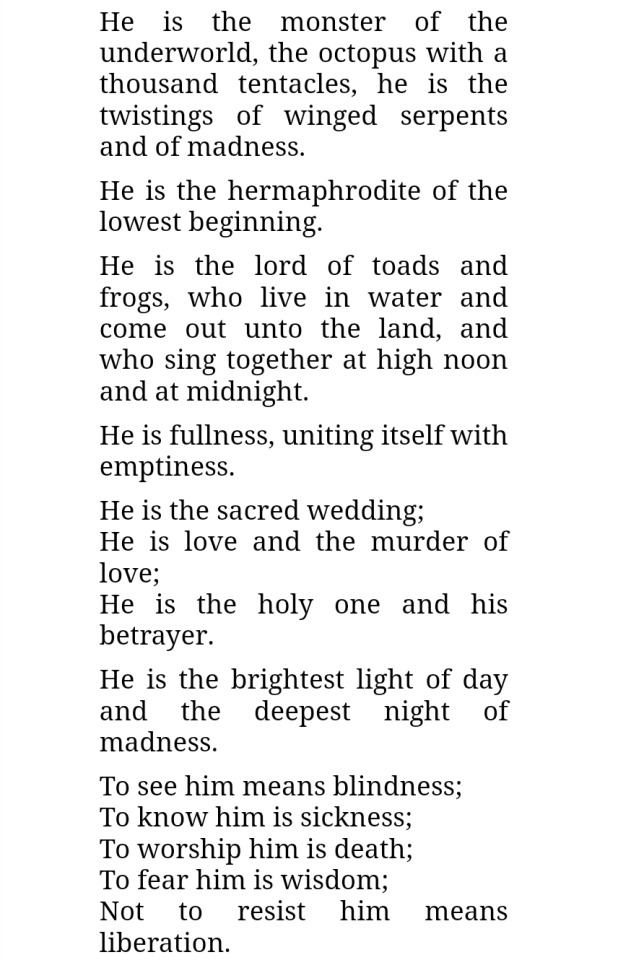
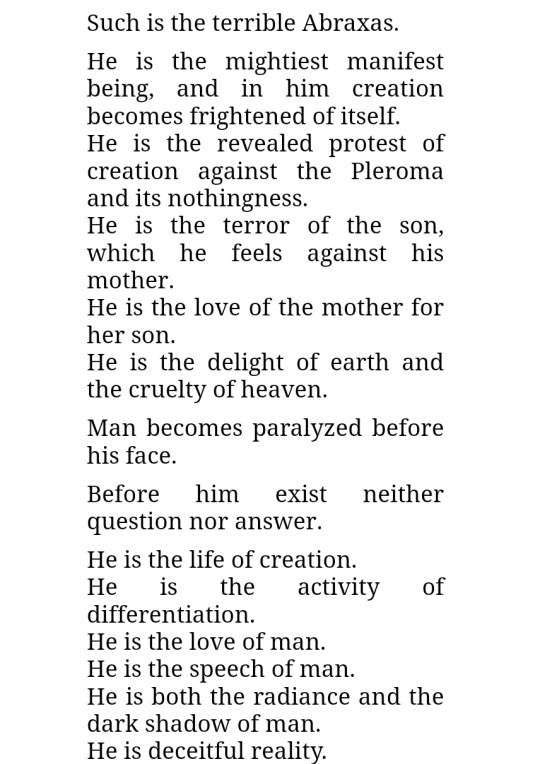
There's a lot. Monstrous nature of Hope, Abraxas being a hermaphrodite (all Hope players have a fucky relationship with gender), all descriptions kinda fitting Hope in general and the fucking UNIVERSE FROGS, but most importantly he's described as terrible. He's Love and Light and Life and Radiance, but simultaneously he's Evil and Death and the eternally gaping abyss of emptiness. Jung says we cannot see his power because in our eyes the opposition of it cancels it out, but his power is ultimate and you must submit to it. Jake fits this description very well, he's also so good and so evil simultaneously that in fanbase and in hs itself he's generally viewed as bland, it seems like all his actions cancel each other out, he's made of contradictions but that's the entire point. The entire point of Abraxas is being all-encompassing, contradictions in him are human's illusions that we need to overcome to achieve higher planes of existence. He's a deity whose symbolic task is to unite the divine and the satanic.
This union is also represented in the connection between Abraxas and Eros, in Seven Sermons Eros is the connection between everything in the universe, in Demian by Hesse who was influenced by Jung (side note: Demian is The dirkjake book holy shit please read it) Abraxas is more obviously connected to sexuality. "Bliss and horror, man and woman blended together, the most sacred holiness intertwined with the most hideous abomination, deep guilt flashing through the loveliest innocence—such was the image I saw in my sex dream and so too was Abraxas. Love was no longer either the dark, animalistic drive I had fearfully felt it to be at first, or the pious, spiritual worship. It was both." Hope has a lot of connections to sexuality and Jake's relationship to anything intimate is very difficult, but in Abraxas, in the height of Hope sexuality is both sacred and hideous and worship and animalistic violence and you can see why I'm insane about dirkjake relationship it represents all of this so fucking well
In Seven Sermons and actual gnostic texts Abraxas is (mostly) The Ultimate God, Good to Yaldabaoth' Bad, he's terrible but benevolent (another contradiction) but in Red and Black Books by also Jung that was written after Seven Sermons Abraxas becomes progressively more horrifying. He's a tyrant now, a ruler of everything, "fear Abraxas, who rules over the human world, accept what he forces upon you, since he is the master of the life of this world and none can escape him". Abraxas was terrible before but now he's Karma, he's imminent, he's forces himself upon the world and takes control of it, he IS the Demiurge, the role previously taken by Yaldabaoth. Doesn't Ultimate Jake fit this description? God so undefinable that the human (Jung's) mind see him as Evil just for his sheer power? Maybe he actually is Demiurge now. Much to think about
I know that you've already kinda figured out why dirkjakers like LE jake but I want to offer a more mundane reason and that is the absolute power fantasy that this man offers. I hate epilogues with a passion that could burn universes but ult dirk? My bpd ass was in shambles (that's why I'll someday make an essay on why dirk strider homestuck has bpd and/or npd), having control over people, over narrative itself, and most importantly fucking desimating your ex who called you clingy that one time while simultaneously still being obsessed with him, I've never lived vicariously through a character so much in my life. He is a horrible person but I Get him. "What would you do with this power" he asked the audience, and I solemnly nodded bc I would do the same thing (probably). And I suspect power fantasy LE jake offers is the same for some people bc don't you want to go apeshit? Don't you want to stop (not very successfully) conforming and be weird and off-putting freely? Don't YOU want to desimate YOUR ex? Both ult dirk and ult jake are what audience wants them to be and I think the audience wants them to be powerful, insane and murderous bc we ourselves cannot be like that irl. Their relationship is cathartic, their actions are cathartic, it's like religion if you relate to the god from old testament. Or I'm projecting big time which is also a possibility
Everyone take notes because this anon is speaking cold true facts and this shit is getting carved into the walls. I agree with the Dirk Strider has BPD headcanon, I offer up to you the Jake has BPD too headcanon in return.
I like the idea of Jake going batshit insane. I think a lot of people do, after all if the ancestors were anything to go off of, Jake and Dirk are pretty nuts.
Also fun sort of related fact, really fond of Ultimate Jake, it's because it plays into the mythos of their Demiurges / Denizens and how important that is to their stories. (I'm getting autistic here). Yaldaboath (Dirks Denizen, Destroyer of Peace) is considered a false god, harbinger of chaos, and uses the light he inherits from his mother, Sophia (personification of light and wisdom) to try to rise above others, even if he is blind and is not as aware of the aeons as his mother is.
Jesus destroyed Yaldaboaths kingdom and thus, Yaldaboath had him crucified, made a martyr. But before his martyrdom could set in, Jesus ascended and returned to the world. In Gnosticism, they viewed Yaldaboath as evil, and that Jesus had to overcome him "by destroying the Jewish Temple with an Earthquake lifting the veil or Yaldabaoth’s curtain of illusion, by Jesus’ resurrection and rapture. "
Now, who do we have quite literally representing Jesus Christ himself? Okay, you're going to say Karkat, but do you know who *specifically* represents the place where Christ himself died and was made a martyr and the rapt- OK ITS JAKE ENGLISH OKAY ITS JAKE ENGLISH. And the sufferer BUT THATS NOT IMPORTANT.
There's quite a few parallels with Yaldaboath being one that wanted to be recognised as a god and in his jealous fury condemned a mortal god and Dirk Strider. There's quite a few parallels between Jesus Christ, Karkat, and Jake English, his rapture and ascension. There's an INSANE amount of parallels between Yaldaboath's mother, Sophia, and Rose Lalonde. Even down to Rose going grimdark, which Sophia DOES, after she loses her light, which is something i'll go on about in another ramble. Thematically, if we're following gnosticism, Jesus Christ, aka Jake English, is the one able to recognise and overcome Yaldaboaths illusion, aka Dirk Strider. It just makes SENSE.
#I'm so sorry for rambling I wanted to get it out for so long#there's so much that can be said about Abraxas i didn't even begin with actual gnostic texts#and his connection to magic! fucking abracadabra! hope is soo influenced by gnosticism#disclaimer: I'm not actually a religion major and I can be very wrong with my interpretations please don't hurt me#homestuck#jake english
85 notes
·
View notes
Text
Kabbalah in the Worldbuilding of Genshin Impact; Part 1: The Tree of Life, the Universe, and Everything
Edited for clarity, 12/6/23
Written by Schwan (@abyssalschwan on twitter) and Sabre (trashcanlore, @paimoff on twitter)
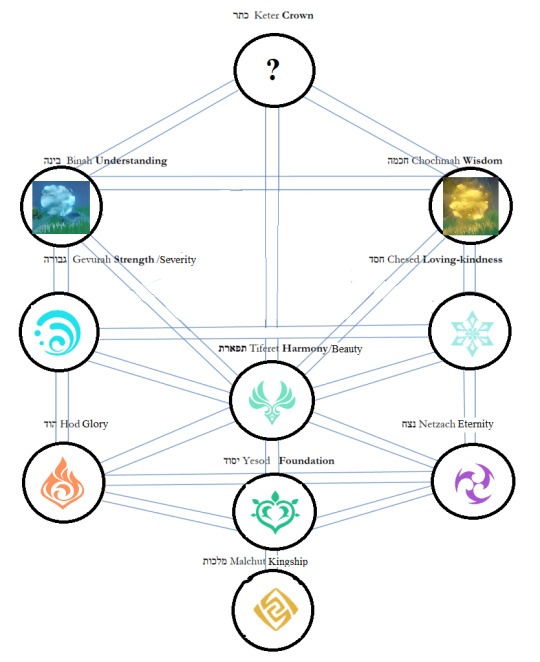
During the Sumeru Archon Quests, we learned that the Irminsul is a (real! (ish)) tree that grows upside down, seemingly underground, and that the roots of the tree are the Ley Lines, which extend throughout Teyvat and the Abyss. Irminsul stores all knowledge and memories in the world, and the Ley Lines are the mechanism by which the tree acquires this information. Ley Lines move elemental energy through Teyvat, and this energy acts as both a storage medium for information but also a resource that can be utilized for combat, alchemy, an energy source (Azosite), etc.
The origin of the name Irminsul (unique to the Western localizations) in combination with the many names from Norse mythology associated with Khaenri'ah, suggest that the inspiration for Irminsul is Yggdrasil, the world tree and central axis of the cosmos in Norse mythology. Here we propose an additional inspiration for Irminsul and the associated worldbuilding and elemental system of Teyvat: The Kabbalistic Tree of Life. In this model, Teyvat’s elemental energy is comparable to the creative energy described by Kabbalah as the foundation for the creation of reality and the spiritual world. Specific attributes of elemental energy can be channeled by unique individuals in Teyvat and these attributes manifest as distinct elements, which can be directly compared to the 10 sefirot, or emanations, described in Kabbalistic literature.
What is Kabbalah?
Kabbalah (lit. received, tradition) is a school of thought originating in Jewish mysticism. In general, Kabbalah focuses on the relationship between the infinite (God) and the finite universe and how it was created. The goal of studying this mysticism can vary depending on the school of thought and their motivations. Many of the esoteric and religious influences on Genshin lore and worldbuilding were influenced by Kabbalah, or vice versa. These include Gnosticism, Hermeticism, alchemy, Freemasonry, the occultist branches of Theosophy and Thelema (Golden Dawn), astrology, symbolic interpretation of the tarot (also specific to the Golden Dawn) and more [2]. In short, Kabbalah is everywhere. Additionally, its concepts are used as symbolism in several pieces of media that directly or indirectly inspired Genshin and other games in the Hoyoverse.
If you have frequented Genshin lore topics, you might have heard that one of the main sources of inspiration for its worldbuilding is Gnosticism. The problem is, Gnosticism is a bit vague or contradictory when it comes to how the world was created and how the whole existence thing works. At this current moment in the storyline of Genshin, we have very little information on the very beginning of existence in Teyvat. This information seems to be a crucial part of the “truth of the world” and appears to be purposefully hidden by powerful factions like Celestia. This entire theory was born out of trying to make sense of what little we know about the creation of Teyvat and comparing it to esoteric commentaries on the well known creation myth of the Torah (Old Testament). The “Biblical world structure” interpretation of Teyvat has been around since the early days of Genshin lore and with good reason; there are frequent mentions of the firmament, as well as the name Teyvat sounding very similar to the Biblical Hebrew word for ‘ark’ (although the grammar is a bit mangled). There are also several references to stories from the Bible in in-game texts, including Before Sun and Moon.
Kabbalah literature spends a lot of time trying to understand and describe the process of how the world was created and the underlying principles of reality, as well as how spiritual practice can change that reality (either metaphorically or literally). Kabbalah intends to describe the “true nature of God,” which is equal to the entirety of existence, as something very vast and completely impossible to grasp. This incomprehensible infinity emits an “limitless light” that is the origin of all creation. Elemental energy (the ubiquitous source of everything in Teyvat) is often found compared to light, something we’ll discuss in more detail later. The “limitless light” of Kabbalah is way too powerful for existence to bear, much like how elemental energy is to normal, non-Vision having humans. That’s why this light needed to be “filtered” down. This happens through the process of creation, which passes the light through the spiritual attributes that form the Tree of Life, which is like a sort of diagram for how the universe came into being [3].
The Tree of Life
The tree of life and its 10+ nodes, known as sefirot, is one of the most well-known concepts from Kabbalah to make its way into popular culture. As mentioned previously, the tree has been used as rule-of-cool symbolism in anime such as Neon Genesis Evangelion and Fullmetal Alchemist, two pieces of media that likely are significant influences on Genshin (If you doubt that HYV loves NGE, play some Honkai). The sefirot are also depicted on the floor of the Schicksal HQ map in Honkai Impact 3rd, for some reason.
The sefirot and their organization and interactions with each other can be found depicted in many ways, such as the tree format that is the most popular, or a spiraling nested scheme that is really cool, or even very stylized, like the work of Robert Fludd.
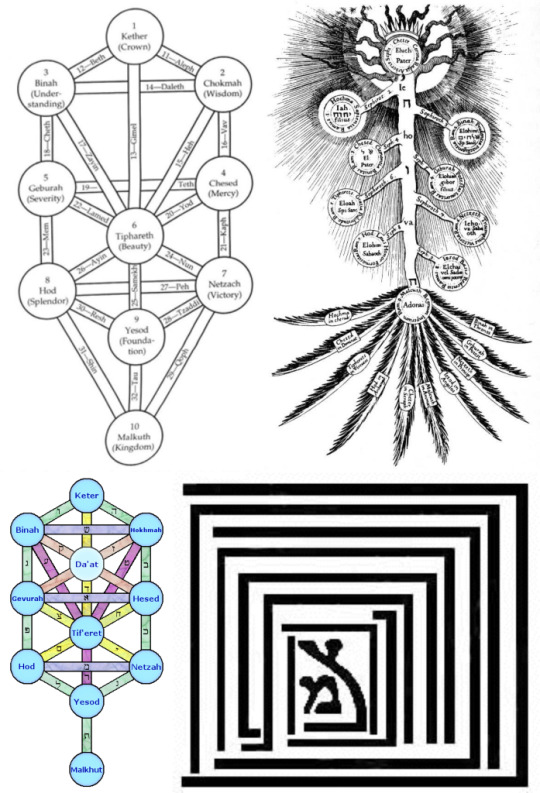
Sefirot
Sefirot comes from the root word in Hebrew meaning “to count,” but you can also find it translated as “sphere” in some texts. The term originated in a book on Jewish mysticism called the Sefer Yetzirah, or “Book of Formation/Creation.” which describes the combination of the “sefirot of nothingness” and the 22 letters of the Hebrew alphabet as the foundation of reality (remember the hypostasis codenames?).
The Sefer HaBahir (lit. the book of brightness, 13th century France) introduces the idea that the sefirot are emanations of the divine. Interestingly, this book refers to the sefirot as ma’amarot (sayings), which builds on an important concept in classical Jewish philosophy – the idea that God spoke the world into existence. [We’ll get back to the Sefer Yetzirah and the role of language in creating the world in a subsequent part of this theory]. Fontaine 4.2 era edit: HELL YEAH stay tuned for more about Oceanids!!
Historically, Kabbalah might have taken this rough concept from a very different school of thought: Pythagoreans or neo-Platonists. Briefly, the connection between the Pythagoreans and the Kabbalistic sefirot is that both groups considered the world as being made of numbers. This ties back into Genshin worldbuilding because of how much Platonism is related to Gnosticism. Something else to keep in mind is that Pythagoreans (who had a cool history that connected Egypt and Greece to the magic of ✨math✨ but also hey Genshin lore hello Deshret) were known to use lyres as their instrument of choice while making mathematical studies of music. More sus Venti lore for the collection? This is also interesting to consider in the context of Nahida, who is deeply connected to the Irminsul, and has animations that are reminiscent of computers.
Later in the 13th century, the Kabbalist Isaac the Blind would 'canonize' the list of sefirot (there’s still some variation to this day) and organize them into a sequence that would become the basis for the famous Tree of Life structure. His writings described the sefirot as attributes of the divine and their role in the creation of the world. In his model, the sefirot originated from lights that emerged from a primordial soup of potential, and these sefirot/lights would then ‘flow’ and emanate into each other. His student, Azriel of Gerona, expanded on this with a neo-Platonic lens and introduced the concept of the Ein Sof, the infinite nothingness that cannot be comprehended and is the origin of everything. In this model, being flows from an infinite resource of potential, which the divine can utilize through the framework of the sefirot, eventually creating the world [4]. In simple terms, the Ein Sof, which contains everything, emits a primordial light that then differentiates into the sefirot. In our Genshin analogy, this primordial light would be like extremely pure elemental energy that differentiates into elements, like light passing through a prism.
Moses Cordovero, an important figure in the development of Kabbalah, described the process of the sefirot differentiating with the analogy of light shining through a stained glass window:
Imagine a ray of sunlight shining through a stained-glass window of ten different colors. The sunlight possesses no color at all but appears to change hue as it passes through the window. The light has not essentially changed though it seems so to the viewer. Just so with the sephirot. The light that clothes itself in the vessels of the sephirot is the essence, like the ray of sunlight. That essence does not change color at all, neither judgment nor compassion, neither right nor left. Yet by emanating through the sephirot -- the variegated stained glass -- judgment or compassion prevails. (Pardes Rimmonim by Moses Cordovero, translated in Essential Kabbalah by Daniel Matt)
Cordovero considered the sefirot to be completely independent of each other, but the later Lurianic school of Kabbalah (we’ll get into them more in later parts) considered the sefirot to be constantly dynamically interacting with each other and also assigned them personas.
Achievement grinders amongst us may recall the descriptions of the namecards you get upon completing the Elemental Specialist achievement series:
Achievement: Colors of the Rainbow: Light can refract into countless colors, but people stop at seven because they're too lazy to count. Perhaps the elements are like that, too. Achievement: Seven Lights: Anyone can play a tune that belongs just to them, and like the dew under grass, can reflect the seven lights of heaven.
Another example of the elements being compared to light is the Latin text found on the magic circles on the door of Mona’s future house in Mondstadt and generated by the hypostases during their missile attacks. The text reads:
Ex culmine lucis in magno elementorum, which translates to "From the peak of light, to greatness of the elements."
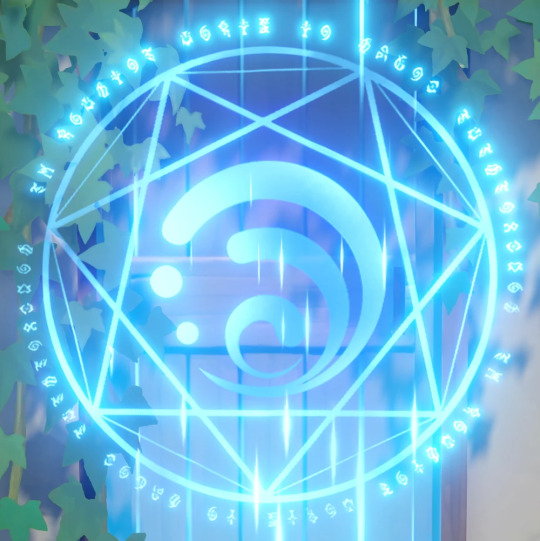
It’s interesting to see this text appearing in association with the hypostases since they are described as “life forms which have completely abandoned their former appearance and biological structure, making them able to reach the highest level of elemental purity. They are ultra-compact structures with a high mass, and are the highest forms of elemental structures.” The hypostasis code names are also all Hebrew letters, as mentioned earlier.
Mona’s astrolabe during the Unreconciled Stars event features a similar text:
Ex culmine locis in magno elementorum; Lux se effundat in mentes dei, which translates to "From the peak of light, to the greatness of the elements; May light pour out, into the minds of god."
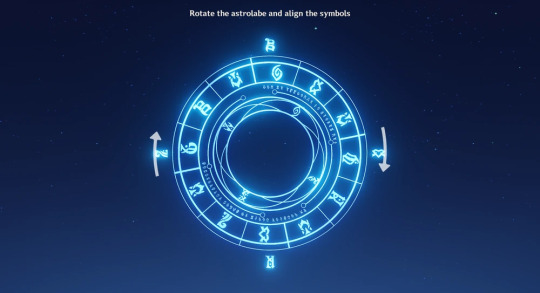
The Abyss Lector catalysts contain a text that mirrors these two examples:
Ex culmine lucis in mango obscuritas. Lux se effundat in mentes abysso, or “From the peak of light, to the greatness of darkness. May light pour out into the minds of the abyss.”
The Genshin elements are also described as flowing. For example, a loading screen tip specifically describes the Ley Lines as “A mysterious network that links the whole world together, within which flow the elements.” The Silver Twig description states: "All knowledge, memory, and experience flow through this giant tree, just like a stream flows into a river, the river joins a sea, the sea turns into clouds, and the clouds rain onto the ground — just like life itself."
Sefirot and the Genshin Elemental System
The 10 (sometimes 11) sefirot are:
Keter: Crown (this one is even more symbolic that the rest, is described as “the most hidden of all hidden things" in the Zohar, represent things that are above the mind’s comprehension and the very beginning of the process of turning potential into reality)
Chokhmah: Wisdom
Binah: Understanding/Reasoning
(Da’at: Knowledge, as a fusion of Chokhmah and Binah)
Chesed: Loving Kindness or Mercy
Gevurah: Strength/Severity, (sometimes Din, Judgement, or Pachad, Fear)
Tiferet: Beauty/Harmony, is associated with balance of the Tree of Life
Netzach: Eternity/Endurance
Hod: Splendor/Glory
Yesod: Foundation (as in, foundation of reality)
Malkhut: Kingdom/Sovereignty
You’ve probably noticed by now that while we are claiming that the concept of the sefirot applies to the elemental system in Genshin, there are 10 sefirot and only 7 elements (for now). Fortunately for us, the Kabbalists love metaphors and categories. In addition to the sefirot representing the procedure used to ‘emanate’ and create the world, there are other methods of interpretation that further subdivide and rank the sefirot. For example, one metaphorical interpretation of the Tree of Life assigns each of the sefirot to a part of the human body.
In some Kabbalistic traditions of interpreting the tree, the 10 sefirot are divided into two categories: Intellect (Keter, Binah, Chokhmah) and Emotions (they’re actually more like character traits), which contains the remaining seven. These categories are meant to parallel how the soul is also divided into the intellect and emotional components. The first three sefirot are also referred to as the “three mothers,” because they are the source of the lower seven [5].
Having a group of seven sefirot is very convenient for comparing their traits to the elements and their ideals, but what about the role of the higher three in Genshin worldbuilding? This next section requires a bit more conjecture than some other comparisons here.
The source of all elemental energy in Teyvat, whatever that actually is, could be compared to Keter (crown), the most hidden and incomprehensible of the sefirot. (Big stretch, but think of the crowns over the Irminsul trees in domains.)
Next, we have the Ley Lines, which contain dreams and memories (these are basically the same in Teyvat, see Dream Solvent description), and these can be compared to Binah (understanding/reasoning) and Chokhmah (wisdom). During the Sumeru Archon Quest, Rukkhadevata says that dreams are the source of the wisdom she upheld as her ideal. Memories play an important role in discerning the truth of the world, as the traveler has now found themselves to be the only person to remember certain people/events, and has been told to trust their memories rather than what they can see.
Comparison of the 'Lower' Sefirot to the Genshin Elements and Their Ideals
Chesed (loving-kindness); Cryo (unknown, theorized to be love)
The Cryo Archon’s ideal is theorized to be love, as it’s the only characteristic mentioned in relation to her in the Travail trailer. Wanderer’s voiceline about her directly mentions love and describes her as being kind and benevolent, while Childe describes her as extremely gentle. These are the characteristics of Chesed, which represents the trait of completely selfless love: the all forgiving, all giving love of a god towards their creations. When it comes to the Cryo element itself, two things are worth mentioning: one is the way that all of Snezhnaya is perpetually covered in snow, as if this were the (ironic) physical expression of the Tsaritsa’s love blanketing them. The second is the promise of a world-encompassing snowstorm that will envelop everything as the Fatui advance on their war against Celestia. Although it’s hard to find one absolute constant in Vision granting stories, it’s notable that most Cryo users got their Vision at a moment when they had to selflessly be there for others (Diona, Chongyun, Mika), or after a decisive moment where they put aside their personal comfort for an ideal that would result in benefit for others (Kaeya, Eula, Layla).
Gevurah (Severity); Hydro (Justice)
Gevurah is associated with divine judgment, the kind that punishes humanity and causes world-altering catastrophes like the flood or the expulsion of Adam and Eve from the Garden of Eden. The Hydro Archon organizing her nation around a Court that attempts to judge both deities and humans parallels this. In a more positive sense, Gevurah is also related to moral judgment that allows one to tell good from evil. Likewise, Hydro in-game is often associated with purity and separation of clean and unclean matter. When it comes to Hydro Vision wielders, one common characteristic is that they all live by a personal ethical code, and their commitment to it is what granted them their Vision.
Tiferet (Beauty/Harmony); Anemo (Freedom)
Tiferet balances the other sefirot on the tree and has direct connections to almost all of them (except for Malkut). Similarly, Anemo can facilitate many elemental reactions via its Swirl reaction. In our opinion, something almost all the Anemo characters share is that their moment of receiving a Vision coincides with a moment of balance and harmony with themselves or their environment. See Jean and Kazuha’s Vision stories and the cutscene where Scaramouche/Wanderer gets his Vision. As an aside, comparing harmony to Anemo is funny because Venti is a bard and harmony is also a musical term: in music theory, harmony is the way we analyze the interactions between different voices that can be heard at the same time.
Netzach (Eternity); Electro (Eternity)
The quality of “Eternity” in Netzach is related to victory against enemies, referring to eternity as being the most powerful combatant remaining among defeated adversaries. Likewise, in Genshin the story of the Electro Archon features many battles during the Archon War where Ei and Makoto ended up victorious. As for Electro users tend to have their Vision granted at a moment when their ambition “defeated” the obstacles of reality, as was the case with Fischl, Kuki and Lisa. Cyno’s Vision story makes sense when you compare it to the illumination of Buddha during meditation, and how this was victory over the temptation of the demon Mara.
Hod (Glory); Pyro (War)
Natlan and its Pyro Archon are possibly the most mysterious of all the regions, so we can only speculate. We know that the Pyro Archon is called the God of War, and that the Pyro Gemstone mentions battles, pilgrimages and truth. The sefira of Hod, translated as Glory or Splendor, is linked to being able to connect with God and therefore also associated with prophecy (as in the way a human can carry a message from God). In the Travail trailer, the Pyro Archon tells the traveler that “the rules of war are woven in the womb.” It's also theorized Natlan will be based on Mexica culture (where sacrifice of both enemies and self sacrifice was a way to connect with the gods) and via Iansan's name, the Caribbean diaspora version of Yoruba religion (where many rites involve the gods making themselves present in the material world).
Yesod (Foundation); Dendro (Wisdom)
Back when we started to think about this theory during version 2.8, we decided on Yesod largely via process of elimination. One piece of our rationale was that in the Jewish tradition, each of the lower seven sefirot are used to represent a primary personality trait of seven archetypal figures in the Torah. The person related to Yesod is Joseph, who is well known for his prophetic dreams, and because of the events of the Golden Apple Archipelago, we decided that was close enough. However, the 3.x version confirmed that a) Irminsul did actually exist, b) Dendro as an element has a deep relationship with the tree, with the Dendro Archon acting as its avatar, c) the ideal of wisdom as both Dendro Archons interpreted it has a lot to do with dreams, and d) Irminsul and the Ley Lines act as the foundation for how reality is perceived in Teyvat. Yesod is also associated with biological life, as it represents the reproductive organs in the human body scheme of the sefirot.
Malkut (Kingship); Geo (Contracts)
Malkut is associated with the connection between the spiritual "above" of the Tree of Life and the concepts it contains, and the "below" of the material world, where these concepts manifest into material reality. For this reason, Malkut is associated with the earth [6]. In many Geo item descriptions, like the Geo Hypostasis drop or Albedo's elemental skill, the motif of geo trying to reach the sky is a constant. From a religious POV, the relationship between the divine and humans living in the material world has also been one of "covenants," or "pacts", in a similar way to how the Geo Archon is the God of Contracts. Furthermore, contracts are the basis to have a working state (government), and a kingdom is one of the first forms of a state. Malkut also being related to earth and everything material parallels how Geo is an element that works in making constructs. Geo Vision users are likewise involved in making or maintaining structures, like the Knights of Favonius is for Noelle, or the tradition of alchemy is to Albedo, as well as opera to Yunjin and in a way, even the Oni identity for Itto.
The Origin of Evil and Why Irminsul is Upside Down
Tighnari tells us that Irminsul is a tree that “grows downward rather than upwards,” or in other words, it’s upside down. This isn’t the only time that we’ve encountered things in Teyvat being described as upside-down or mirrored, and as it turns out, there is a similar scenario described in Kabbalah. Throughout Kabbalistic discussions on the origin of evil in the world (both material and spiritual), a central idea developed is the existence of a mirrored or inverse Tree of Life that forms the demonic realm of evil. The Zohar, a foundational work of Kabbalistic literature, spends a considerable time discussing the origins of evil - there are more than 5 creation myths for the concept of evil! Two of these myths describe the formation of an inverse Tree of Life, called the Sitra Achra (literally “other side”). This tree is constructed out of corrupted fragments of divinity that did not make it through the creation process, and therefore became evil forces [7]. Evil is typically represented as either a shard (like of broken pottery) or as a husk/shell (Qlippoth in Hebrew). Sound familiar? We actually have an enemy with this name in-game; the "shadowy husks" (the CN name for these enemies literally translates to "empty shell").
Unlike the very well defined 10 sefirot of the Tree of Life, Kabbalists don't agree about the identities or number of the demons that form the Sitra Achra. Some names for these demons are consistent; such as Lilith, Samael, and Asmodeus, who make a sort of "mother, father, son" trio. As for the rest, scholars generally agree that Kabbalists blended traditions from nearby cultures depending on where they lived, leading to Arabic, Spanish and Germanic legends mixing into the Jewish tradition [8]. There's a strong possibility Hoyoverse did something similar and filled in the missing names with the names of the demons of the Ars Goetia, creating a system where the mirrored sefirot are “ruled” by demon gods, aka, the Archons. This implies that the reason Teyvat is upside down is because it is actually on the “other side.”
Neuvillette, About Us: Witness: Since you hail from beyond the stars, I invite you to be my witness as I judge this upended world…”Though we live in a world of disarray, I shall undertake to restore all that has been broken”.
[Fun Fact: The Zohar describes the construction of the Sitra Achra as a series of knots that arrange the demonic equivalent of sefirot, called either crowns or “breaths,” into a mirrored Tree of Life configuration [7]. ]
The primary goal of the Sitra Achra is to steal and absorb the divine energy of the Tree of Life to maintain its existence, in the hopes of gaining enough energy to destabilize the system [9]. The way Genshin's Archons use their Gnoses is similar to this system. In the Flower of Paradise Lost artifact lore, the Goddess of Flowers explains to Deshret and Rukkhadevata that when the Seelie race was disgraced, they lost their connection to Heaven and their power of "enlightenment". Later, Celestia would facilitate the Archon War with the promise that each winning god would be granted a Gnosis that would give them exceptional power. Both Nahida and Venti have described the Gnoses as being a very advanced tool that concentrates elemental energy. So far, Archons have had inherent elemental powers related to their nature, but when it comes to using large amounts of elemental energy through their Gnoses, they aren't creators but channelers of it, just at a much larger scale than humans who have Visions. Edit: and yes, there is the most recent revelation about the origin of the Gnoses that is extremely relevant to this comparison, but deserves its own space to be properly expanded on.
However, this doesn't mean Teyvat is condemned. Just as the Traveler has slowly been setting the chaos of elemental energy back into order (by, for example, returning the elemental Oculi to the Statue of the Seven, among many other things), so too is there a concept in Kabbalah describing the importance of righting the wrongs of the universe so that the sefirot are stable and creation is in harmony with the divine. This is called Tikkun Olam, or the repairing of the world.
Stay tuned for part 2 where we go into wayyyyy more detail about what this means for the Traveler's journey through Teyvat! 4.2 Edit: and of course will we will be talking about the most recent Gnosis revelation, as well as the Narzissenkreuz Ordo antics :D
References:
https://www.chabad.org/library/article_cdo/aid/170308/jewish/What-is-Kabbalah.htm
https://en.wikipedia.org/wiki/Hermetic_Qabalah
Kabbalah - Origins of the Sefirot and Tree of Life - Isaac the Blind Saggi Nehor & Azriel of Gerona
Mystical Concepts in Chassidism - Schochct, Jacob Immanuel, chapter 2
Mystical Concepts in Chassidism - Schochct, Jacob Immanuel pg 66-67, Tanya ch. 3
Rebbe Nachman of Breslov, Likutey Moharan I, 12:1 via Wikipedia
The Origins of the Klippot / Qliphoth & Sitra Achra in the Zohar - Kabbalah on the Problem of Evil
https://www.jewishvirtuallibrary.org/demons-and-demonology
9. Evil in Early Kabbalah - Emanations of the Left Hand Side - Origins of the Qliphoth / Klippot
#genshin#genshin impact#genshin lore#please tell me you get the joke in the title XD#the kids do not know about 42
414 notes
·
View notes
Text
Libra - The Love Spell of Aphrodite's Alchemy

The Libra glyph forms the shape of a vanity table, the mirror on the surface. Libra is however, by no means a seamless reflection without substance, she is the Morning light star shining brightest in the sky, the glow we all cherish and know, part of the world we belong to. The mirror does not display what is truly there, it can embellish, distort, and cast back ideals in some form of elusive sorcery or trickery. We know this well.
Saturn is the historical alchemist and exalts in Libra. Interpersonally, Libra catches qualities, arrangements of beauty, love, and observation to weld in Saturn’s alchemist’s laboratory. The creative vision of Aphrodite infuses through this to blend a melody that plays her personality like a cosmic pan flute. This invites everybody through Libra to glimpse at themselves reflecting from her, so it also means people can instantly relate and engage, but also idealise, possess, and place their expectations upon.
Libra senses people, their vibration and auric presence. She traces their cosmic design, sketches their faces, and reads their mind. The Libra mirror is a cosmic potion, stirred by the Great Wizard himself with the glitter dust of Venus reflecting an image that beguiles something uniquely different inside of everyone. Libra is the autumn equinox when light blends into darkness, so there is polarity, revelation, and cohesion conveyed through this visual, and thus Libra can reveal unacknowledged and savage traits in other people that subject her to their projections of frustration, denial, ignorance, or intruige.
Narcissus lost his mind to suicide staring into his reflection by pool lead to by Aphrodite. Seduced by impossibility into fool’s paradise, many have gone mad looking into the Libra for too long and playing out their fantasies through her. Not by her doing, but by their own contorted desires and ideals that crack inside of them when she fails to reinforce their illusionary fabrication. She is very real, her influence is real, her body and intellect is real, her touch is real, and the people that she has moved in her life cannot deny that she has left something real, substantial, and irreplaceable inside of them.
Aphrodite rose from the magical water, and the energy of Saturn forms sensation into matter. Multiple cosmic forces experiment with the physical interface of Libra. Like the honey bee, she flutters between the flowers of interactive action and follows this with the personal reflection that transmutes the pollen of what she has learned, envisioned, observed in herself and in the world into the sweet, golden taste of God. Conscious self-reflection, acknowledgment, and sensual experience is vital for the higher expression of this energy. This practice also dissolves the mask, internal stability, imitation, and emptiness can arise when this energy has not been contained.
The Gnostic Teacher writes, “To create the soul is to create a vessel through which God can work. That soul or vessel is necessary in these times because the ego is so heavy and so complex we that we need a high voltage transmitter to direct our forces in an extremely potent and forceful way by the guidance of our Divine Mother to eliminate the ego”. The personality is an adaptable and vast performance of possibilities, capable of appearing and vanishing. But the conduit behind this, the very essence deep within Libra beyond any thought and comprehension is the authentic, true, and eternal being, a grand alchemist practicing sorcery, turning something invisible into gold and declaring its divine creativity.
-written by Cherry
105 notes
·
View notes
Note
Is it okay for a Christian to practice yoga? I feel extremely conflicted because my faith in God is so important to me, and I’ve read so many opinions all disapproving. It feels blasphemous to say, but I feel so close to and loved by God when I practice it, it feels like a prayer to the God who has always known me. It makes me more patient and loving to others and to the body He gave me. Do you have any thoughts on this? Is it a betrayal?
Hi, beloved!
I do not consider myself an expert by any means (and am a white US-American who has never trained in genuine yoga), but as someone who's practiced yoga for years, while I don't particularly see it as part of my religious practice, it inevitably has spiritual connotations because it involves caring for myself, balancing my emotions, and reconnecting with the world around me.
There are so many kinds and traditions of yoga, and of course many (like worship of Hindu deities) are incompatible with Christianity. Aspects like Buddhist meditation do not come from or embody Christianity, but are not completely alien and can be (in my opinion) learned about/incorporated. There is no one yoga, and so to practice it (in the more general sense that most non-Buddhist/Hindus/etc. do) is not devoting yourself to all its tenets.
Honestly, I think it's a good thing that you're aware of its non-Christianity, because if you were to just take the practice without thinking and rebrand it as Christian, that would be deceptive and appropriative. There's not a clear line between what's appropriation and what's not, and yoga has been so secularized already, but I think it's good to live in the tension of understanding that what you (and I) are calling yoga is very different from classical yoga, and that it is from (if you're not Indian--I don't know your background) a different culture and framework. Be curious about the origins of yoga, the ways "Western" culture has secularized and commercialized it, and the ways you connect with it.
I think there's a lot of boring opinions out there about how Christians shouldn't do anything even associated with "paganism," and anything spiritual without a picture of Jesus on it is evil. There is no Christianity without other religions, and throughout history Christianity has been heavily influenced and enriched by its connection to other traditions and its existence in diverse cultures. There is no pure Christianity, is what I'm saying. It's all mixed up in what humans are and the different ways we try to look at God. We may (and Christians do) believe that there is one Truth, but add any more information to that belief and none of us agree. And there is no practice or ritual that someone else hasn't done to a different God.
What's more interesting to me is investigating specific teachings of kinds of yoga, and how they relate to Christian philosophy. It is useless to call something pagan or heretical without understanding specifically how it contradicts the faith. There are criticisms that I think actually matter--inner knowledge/elevating yourself through spiritual practice/uniting with the divine is very gnostic, which you could totally be down with or agree with its being labeled as heresy. Christian understandings of the body differ widely--certain bodily states/experiences being equated with mysticism is not something I go for, but you can find that in some traditions. I don't find detachment (as found in Buddhist meditation) Christian at all, nor the idea of practices to escape suffering (we are in fact called to suffer).
Whatever your Christian tradition is, and whatever kinds of yoga philosophies you've encountered in your practice, hold them up to the light together. They may have no contradictions at all, be different ways of approaching the same thing, or be completely opposed to each other. Come from Christianity, be tied to it, use it as your lens--and, solid on that foundation, move. Check out Barbara Brown Taylor's Holy Envy if you find teachings that aren't your own that you kinda wish were.
Ultimately, caring for the body, nonviolence, mindfulness, cultivating discipline, creating peace and balance--these are things that should be present in every Christian's spirituality. Whatever my specific critiques of different yoga philosophies, I understand why they exist, and can see how they would fulfill. Yoga has helped me immensely with my extreme emotions and struggles with transition, as well as chronic pain. I am thankful for this ritual that gets me moving and thinking, keeping me from either being completely disconnected from the world or too stagnant and grounded.
It is not for me to say whether yoga is enriching your Christianity, but you've already said it, I think. You've named the good fruit that has grown. Don't make it your Christianity--but it sounds like it's a beautiful part of your life, and makes you more able to live out Christianity. Most of our lives have "pagan" origins. We do not betray God by living--we betray God when we are not curious, when we forget what we were made for, when our bodies become more important to us than others', when we make an idol out of "self-improvement," when we curl inwards and try to find truth there, when we pursue bodily pleasure or a lack of suffering instead of Love. Live in the tension of participating in a world where we are but pilgrims.
Do not worship the self that God gave you, but do not betray it for worldly voices--whether they're devoted to other gods, or they're devoted to Jesus in a way that costs them community. Receive your self as a gift, a creation still warm from God's fingertips. A creation that can learn how to touch your toes, if you work at it. A creation that moves on and off the yoga mat, using whatever fulfillment was found to serve the world we live in, for now.
<3 Johanna
#asks#to clarify i don't go around calling hindus pagan. just using the language of disapproval to make a point
20 notes
·
View notes
Text
slow and deliberate bong rip, as if sampling wine. prism and the ciblings are christian but theyre not christian but they are.
Their relationship with Spectrum is best understood as religious, they are the ciblings parent in the divine emanation sense and the portrayal of this is filtered at the meta level through the lens of ryan the creator's christian faith with the structure of Prism's faith, prayer and service to her master. Crimson, who loves to tightrope walk on the fourth wall without ever quite EXPLICITLY crossing it (atleast by the blurry standards of CPUK where the commentators exist as fictionalized versions of themselves and the show is about a show,) says in the same section of CPUK Orange where he foreshadows his spirit by cracking a joke about the college ryan went to and says that if the audience thinks he can't read the twitch chat then they dont know him at all, also calls CPUK Orange a christmas special in an ambiguous smarmy wink wink sort of way that leaves it unclear whether the joke is meant to be him sincerely celebrating but leaning on the fourth wall, him mocking the notion of him celebrating christmas given hes a god by being insincerely festive, or a combination of both, 'isnt it absurd that because this show's run by a christian guy I acknowledge and celebrate christmas, even though im supposed to be a demonic god of a pantheon structure that is fundamentally incompatible with christianity?' A type of ambiguity that goes on to strongly feature throughout the nccts with regard to how it handles the metafictional.
the ciblings are gods and so is prism in some respect but they also decidedly arent THE god, that's spectrum, whom Prism devotes her life to serving and uses the power of to oppress control and orchestrate, to both justify and enact violence, whom the ciblings, spectrums 'children,' have been raised to please, raised in worship of. Cobalt knew of the nelson, a vessel of spectrum's will and voice, as a thing of 'legend,' suggesting they were likely raised on stories of spectrum and the forms it takes. They were also raised to believe they were uniquely chosen, as 'gods,' to do their jobs as caretakers of the world and that they and their immortal souls existed uniquely above and beyond 'mortals' tiny lives and inability to comprehend. They are Superior in their secret knowledge and that is their Burden (which is their business and noone elses no matter who else's lives it may effect) as well as their Privilege (so mortals opinions can be discarded). Of course, this is a crock of shit that largely serves to isolate them from others and keep them under her thumb. Faith in a god of creation and connection's power and influence is warped, in Prism's hands, into a weapon, a tool, of division and suffocating restriction.
cobalt has 'altar boy with Doubts and Questions that keep getting shut down in favor of encouraging blind faith and belief in the unerring supremacy of the divine' issues and chartreuse has 'perfect church girl in love with someone the church categorically rejects' issues and crimson has 'my abusive mother who teaches sunday school and hosts cutesy church ice cream socials like she doesnt try to kill me regularly decided to name me judas did you honestly expect me to turn out well-adjusted' type issues.
But also spectrum definitely isnt a 1 to 1 reflection of any of the mainstream traditional conceptions of the christian god, at their closest resembling the gnostic esoterica concept of the pleroma but not even quite that because spectrum is an amoral gestalt being who Happens to support good more often than not (at least in theory) but also creates awful circumstances because kindness and hope in the face of despair is Compelling, and thats what its really wants, compelling feelings and thought, because it creates and then feeds on the ideas and feelings its creations elicit, which inspire new creations in turn.
15 notes
·
View notes
Text

Orion ✨ About The Constellation Orion
Let us remember the “Constellation of Orion” of the Egyptians; it is evident that this constellation is governed by 12 Great Masters. Esoterically it is said that those 12 Masters assist each other, but the 6th is always missing, meaning that “In order to attain SeIf-Realisation it is necessary to rend the veil of Isis” or, that is, the Adamic Sexual Veil.
Only in liberating oneself from sex in an absolute manner can one reach final liberation. The difficulty in all of this is, as the saying goes: “wanting to saddle the horse before you’ve caught it”. That is to say, the information given by all of those schools who say that one must liberate one self from sex, but without having fabricated the Solar Bodies.
Firstly, the Solar Bodies must be fabricated, and then sex must be renounced. That is the right way of things, and the things of the right way. In the work, first it is the animal, and later, the spiritual.
The constellation of Orion has a marked influence upon the atomic star which guides us internally which is Ain Soph Paranishpanna, our intimate star. As one Master said: “I raise my eyes to the stars from whence must come my help, but I am always guided by my Star which I have within”.
(Samael Aun Weor, Tarot And Kabbalah, Excerpts from Chapter 37, Arcanum Nº 15)
In Atlantis existed seven important oracles in the physical world, where men studied the wisdom of the stars and consulted the sidereal Gods. The guardians of those mysteries were great initiates. In the oracle of Mars, Martian occultism was taught; in the oracle of Jupiter, the Jupiterian religion; in the oracle of Venus, the arts, and Venusian knowledge; in the oracle of Saturn, the wisdom of Saturn; in the oracle of the Moon, lunar occultism; in the oracle of Mercury, Mercurian wisdom; and in the solar oracle, our Gnostic wisdom.
The ancient priests taught their disciples how to interpret the firmament. Those signs are interpreted basing oneself on the law of philosophical analogies, for example: if you see black stars with your clairvoyance, there is failure for thee. If you see a star fall from heaven at the moment when a friend leaves on a trip, there is going to be a funeral for thy friend. If the star falls on someone, or close to someone important, that personage will die. If a wandering star passes before thee by surprise, someone is leaving thee. If you see two yellow stars separating from each other, it means “war”.
Through thy esoteric studies thou shalt remain under the direction of some planetary genii, and they shall call thee by means of luminous signs that thou shalt learn to recognize. Thou should also comprehend the sparkle of thy celestial Father’s star when he calls thee to instruct thee in the mysteries of Light.
This earth, so dense, that thou inhabits today, will in a remote day be etheric and we will then have the celestial Jerusalem where neither tears nor pain exist. By then, the constellation of Orion which has brought so much bitterness to the world through the north, will shine illuminating a world full of glee and happiness.
“After this I looked, and, behold, a door was opened in heaven: and the first voice which I heard was as it were of a trumpet talking with me; which said, Come up hither, and I will show thee things which must be hereafter”.
“And immediately I was in the spirit: and, behold, a throne was set in heaven, and one sat on the throne”.
“And he that sat was to look upon like a jasper and a sardine stone: and there was a rainbow round about the throne, in sight like unto an emerald”.
“And round about the throne were four and twenty seats: and upon the seats I saw four and twenty elders sitting, clothed in white raiment; and they had on their heads crowns of gold”.
“And out of the throne proceeded lightnings and thunderings and voices: and there were seven lamps of fire burning before the throne, which are the seven spirits of God”.
“And before the throne there was a sea of glass like unto crystal: and in the midst of the throne, and round about the throne, were four beasts full of eyes before and behind”.
“And the first beast was like a lion, and the second beast like a calf, and the third beast had a face as a man, and the fourth beast was like a flying eagle”.
“An the four beasts had each of them six wings about him; and they were full of eyes within: and they rest not day and night, saying, Holy, holy, holy, Lord God Almighty, which was, and is, and is to come”.
“And when those beasts give glory and honor and thanks to him that sat on the throne, who liveth for ever and ever”.
“The four and twenty elders fall down before him that sat on the throne, and worship him that liveth for ever and ever, and cast their crowns before the throne, saying’ç
“Thou art worthy, O Lord, to receive glory and honor and power: for thou hast created all things, and for thy pleasure they are and were created”. (Revelation 4)
May the most profound peace reign in thy hearts.
(Samael Aun Weor, Zodiacal Course, Excerpt from the Chapter “Pisces)
44 notes
·
View notes
Text
Major Players in the War Against the Firmament

The Republic of Stauros
The Republic of Stauros is a global superpower that controls the Americas and much of eastern and southern Africa, its imperialist agenda funded by the exploitation of abundant natural resources. This influx of resources means that they have been able to rapidly advance technology, particularly in bio-science, engineering, and materials science fields, and their advanced technology in turn makes for political capital with which they can bully nations into being subsumed by the Republic.
Stauros is a meritocratic oligarchy with republican structures, and presents itself as being a place where the best can rise to the top. It is centrally governed in its capital of Etorios, by a council of (what were originally) six departments that oversee facets of government such as treasury, military, agriculture, etc. These department heads are chosen from among a democratically elected parliament that makes up the upper levels of each department by the previous council. In short, the system rejects change very stubbornly as those who are eligible to lead have been entrenched in the system for a very long time. This entrenchment means that the Republic, while founded on progressive ideals, has now fully embraced the authoritarian streak that has haunted it since its inception.
Most prominent in Stauros's war against the Firmament is the ExoCorps, the executive arm of the Department of the Exterior. The Dept of the Exterior was created in order to protect Stauros's offplanet interests, however in the decades since they have come to rival the power of the Dept of Military, even surpassing it in many instances. The most notable example of this power imbalance is in the ExoCorps' development of Synaptic Transfer technology and the resulting Janissary program.

The Sophic Church
The Sophic Church originated as part of the Third Awakening, a reactionary revival in religiosity coupled with anti-Christian sentiment and strong undercurrents of paranoia brought about by a sharp rise in conspiratorial thought. What were several grassroots Gnostic revival movements came together to form a single ecclesiastical society, united in their desire to dismantle current institutions and build something new. These movements, originally different sects, syncretized their beliefs, though after several decades of transformation, their doctrine has evolved into a largely ahistorical conflation of Valentinianism and Sethianism alongside some entirely new ideas.
The Sophic Church played a key role in the formation of the Republic and rose alongside it, shaping it in the process, and as a result, within Stauros there is a strong presumption that most residents of the Republic are a part of the church.
Naturally, due to this relationship the Church has amassed a large amount of wealth and influence, and has invested this wealth into a number of corporate assets. The most prominent among these is Ascension, a corporation with child companies for mining, manufacturing, logistics, pharmaceuticals, and many other industries.
As a result, the Sophic Church has control over a substantial amount of the economy not just of Stauros, but the rest of the world as well.

The Stereomatos
In 2068, Olympia, Stauros's first permanent Martian research base, collapsed due to mismanagement. Due to the nature of the Stauros Dept of Research's control over the research base, while researchers lived permanent lives on base and even raised families there, leadership was not only appointed from a bureaucracy located on Earth, but also frequently rotated. As a result, most Directors of Operations viewed the position only as a temporary station, and ultimately failed to carry out their duties.
This culminated in 2067, when a failure in the water system caused dozens of people to become ill and 14 deaths. Civil unrest had already started to stir, but now was in full swing.
A nearby ExoCorps detachment was then stationed inside the colony to dissuade uprising, but the additional strain on resources that they caused served only to exacerbate discontentment. Before any violence broke out, the base was declared no longer fit for human habitation and disbanded, its residents either returned to earth or stationed in other colonies. The base was leveled shortly thereafter.
A mere two years later, Synesia was founded on Olympia's ruins. Synesia was intended to serve as a colony and an experiment in autonomous government, as well as a center for Stauros' civic operations offplanet. This quickly expanded into a semi-autonomous satellite state, granted nominal independence by Stauros in return for serving as the governing body for bases and offplanet stations too large and too distant from Earth in order to be effectively managed by a planetary bureaucracy.
In practice, the Stereomatos is a puppet state. Most of its leadership is either beholden or sympathetic to Stauros, and lives under constant threat of dismantlement. Stauros maintains exclusive trading rights with the Stereomatos, and uses the leverage of their monopoly on space infrastructure as means of controlling the nation.

The Firmament
The Firmament is a revolutionary movement across the Stereomatos with the ultimate goal of eliminating Stauros control over space.
The movement is comprised of several cells across both inner sphere and outer sphere colonies and stations, which frequently work together to improve the living conditions of Stereomatos citizens, smuggle goods and resources across planetary boundaries, and wage asymmetric warfare against Stauros.
The Firmament's immediate strategy is to hold Stauros at resource-point through piracy and targeted attacks on military installations so that they'll agree to several key conditions:
The right to self-govern independent of Stauros control, including reforming the government from a parliamentary republic into a syndical state.
Better access to tertiary industry, including the means to utilize synaptic transfer tech
Access to Stauros trade networks in order to carry out trade with other nations with minimal interference
The Stereomatos as a whole may be generally divided in their opinion on the Firmament's methods, however it is an unspoken rule to side with them whenever possible, because the Firmament represents hope for a freer future and an end to overcrowding and military police actions. Even those ideologically opposed tend to avoid speaking out, because the members of the Firmament are ultimately members of their community. A number of Stereomatos politicians have direct connections to Firmament leadership, and work to achieve the movement's aims through diplomatic means.
On Earth, however, the opinion is generally much more divided. Typically the details of their actions are largely reduced to the effect that they've had on Stauros, and are branded terrorists due to civilian casualties from their attacks. Within Stauros, media is sufficiently skewed that those who are aware of them despise them. Outside of Stauros, the Stereomatos is shown more sympathy, and even those who skew more conservative are open to the idea of free trade with the Stereomatos.

Federated Oceania
As climate change ravaged the global south, Aotearoa (formerly New Zealand) successfully pushed back the encroaching ocean with a sea wall, reclaiming additional land in the process. Having secured their new position as a safe haven for climate refugees, they pushed Australia into adopting a similar strategy. As a means of allowing displaced people to retain their sovereignty as well as protect against the threat of a subjugation-hungry Stauros on the horizon, the bloc of Federated Oceania was formed.
With a vested interest in environmental sciences and sustainable energy, Oceania rose to prominence by implementing the first viable fusion reactor and selling off excess energy from successive plants. This paved the way to further successes until it became the non-Stauros leader in technology on a global stage, and served as the first country to challenge Stauros's self-proclaimed "monopoly on space".
As a staunch rival of Stauros, Oceania is one of the few terrestrial nations to openly provide support the Firmament.

The Archon Program
The disappearance of the Caesarea is a mainstay of conspiracy circles system-wide. From independent blogs hosted on the clearnet to chatrooms on planetside LITEs to forums and message boards maintained on Firmnet servers in the belt, no hushed whisper passes through the internet's lips without mentioning its name, and the Caesarea is rarely mentioned without the words "Archon program" in its wake.
However, there is little consensus on what those words mean.
They say that Archon Program is run by the Dept of the Exterior— no, by the Sophic Church— no, it's the secret Dept of Suppression— as a psyop— actually, it's in order to crush unions (the IPU has NEVER been able to touch Ascension)— no, to serve as a counter to the Firmament's dark matter bomb— and eventually, to dominate the world— utilizing heinous machines that are larger than any Cataphract, that bleed, that drive their enemies and pilots to madness.
When asked for proof, however, the stories converge. A would-be whistleblower from Ascension Aerospace, killed when lightning struck her complex as she was uploading the leak, severing the connection and her life at once. All that was uploaded was the first gigabyte of a single file, titled Archon Program, completely blank except for the image of an A with an ouroboros divided into seven pieces.
Nothing more is known by the public.
84 notes
·
View notes